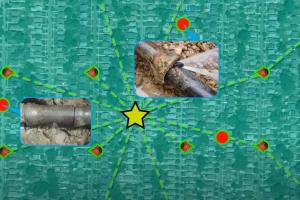Echologics® and M. E. Simpson Co water main inspection
M. E. Simpson Co. secures license to provide Echologics leak detection and water main condition assessment services for U.S. water utilities.
M. E. Simpson Co. was founded in Indiana in 1979 to provide water distribution system evaluation and meter testing services. Along with its head office in Valparaiso, Indiana, today the company has eight regional offices across the U.S. and supplies a wide range of programs and services for water distribution and wastewater collection systems.

After years of locating water main leaks using a variety of listening devices and leak noise correlators, M. E. Simpson Co. purchased two Echologics’ LeakFinder-ST™ acoustic correlators last year and quickly standardized their field crews on the acoustic technology. The company’s field technicians found that the advanced capabilities of LeakFinder-ST such as the low frequency leak location ability and signal filtering made it one of the best tools for locating leaks in a variety of water main materials and diameters.
“The durability and ruggedness of the LeakFinder-ST equipment is truly impressive and it means a lot to a services firm who uses it every day,” said Todd Schaefer, Operations Manager, M.E. Simpson Co.
Subsequent discussions between M. E. Simpson Co. and Echologics regarding leak detection in large diameter transmission mains and pipe condition assessment using Echologics’ ePulse® condition assessment technology led to a licensee agreement signed early this year. Under the agreement, M. E. Simpson Co.’s experienced field crews will handle the data acquisition for leak detection and pipe condition assessment, then upload the data to Echologics’ technicians for analysis. M. E. Simpson Co. will offer these services to more than 1,000 existing customers and to other small and mid-size utilities.
Michael Simpson, CEO, M.E. Simpson Co., added “The combination of our field resources with Echologics technologies will allow us to offer advanced water main inspection solutions to a greater number of utilities to reduce water main rehabilitation costs and to minimize water loss.”





